My poem-books A Word on Statistics and PI came out of a year-long class I took at the San Francisco Center for the Book in 2001-2002 with Emily McVarish and Steve Woodall. My idea was to incorporate my love of numbers into an artist’s book and I spent a fair amount of time looking at how other artists used math and number systems in their work.
![]() One day Steve very excitedly handed me a box of 4 books called “Book of Growth” by Susan Happersett. Each one was a riff on the correlation between plant growth and the Fibonacci Sequence (1,1,2,3,5,8,13,21,34,…). The books use a visual language of grids composed of marks increasing (and sometimes decreasing) in Fibonacci progression (1 line, 2 lines, 3 lines, 5 lines) that represent the growth and decay patterns of sunflowers (bloemen), conch shells, leaves and twigs. While all the books use a similar abstract representation of the sequence, each one has different colors and paper and textures. I was just starting to buy artist’s books, and wasn’t sure what I was doing yet, so I got just one of them — Conch (that’s it above). The brittle pink-tinted handmade cover paper reminds me of shells. The books were letterpress printed and hand-bound at Purgatory Pie Press. You can buy the set through Vamp & Tramp (scroll down to the bottom of the page) or singly through Purgatory Pie.
One day Steve very excitedly handed me a box of 4 books called “Book of Growth” by Susan Happersett. Each one was a riff on the correlation between plant growth and the Fibonacci Sequence (1,1,2,3,5,8,13,21,34,…). The books use a visual language of grids composed of marks increasing (and sometimes decreasing) in Fibonacci progression (1 line, 2 lines, 3 lines, 5 lines) that represent the growth and decay patterns of sunflowers (bloemen), conch shells, leaves and twigs. While all the books use a similar abstract representation of the sequence, each one has different colors and paper and textures. I was just starting to buy artist’s books, and wasn’t sure what I was doing yet, so I got just one of them — Conch (that’s it above). The brittle pink-tinted handmade cover paper reminds me of shells. The books were letterpress printed and hand-bound at Purgatory Pie Press. You can buy the set through Vamp & Tramp (scroll down to the bottom of the page) or singly through Purgatory Pie.
![]() To get a better idea of the marks, here’s a detail from Happersett’s 2005 drawing “Split Tree”. It shows a progression from 3 to 5 to 8 to 13 to 21 marks per grid box.
To get a better idea of the marks, here’s a detail from Happersett’s 2005 drawing “Split Tree”. It shows a progression from 3 to 5 to 8 to 13 to 21 marks per grid box.
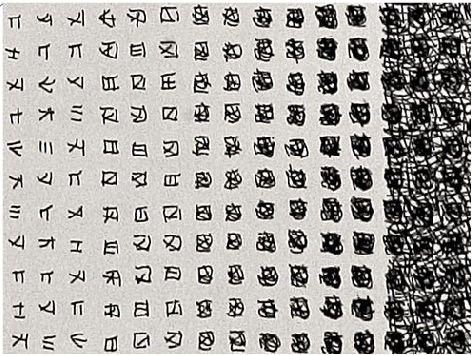

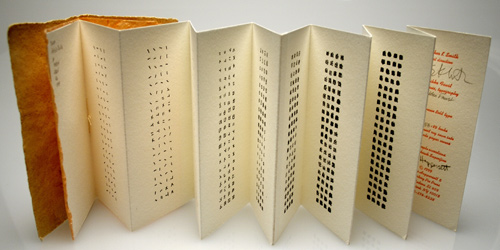
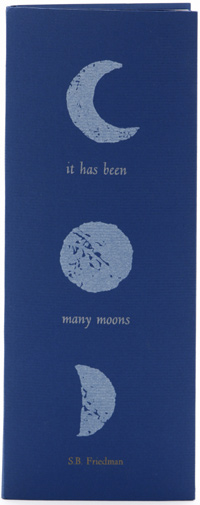
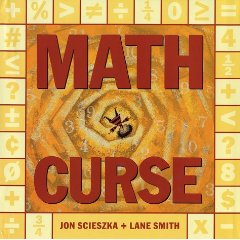
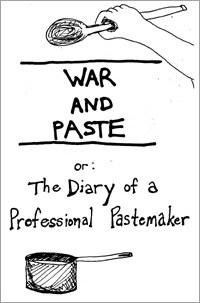
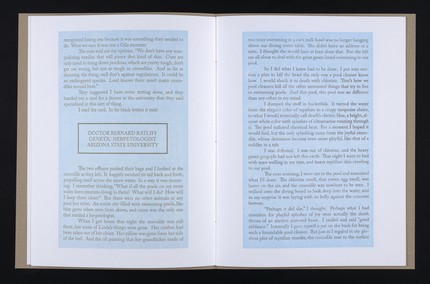
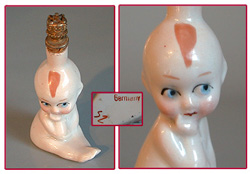 In 1999 my mother-in-law gave me several old perfume bottles, mostly figurines. All from the early 20th century, they are wonderful to look at. As I found out more about them, I got hooked and added to the collection. In a few years I had a shelf-full and decided that was enough. That’s one of mine to the right — a crowntop kewpie doll perfume bottle from the 1930s. Sadly last month she got knocked off her shelf and broke. My husband glued her back together but should I replace her?
In 1999 my mother-in-law gave me several old perfume bottles, mostly figurines. All from the early 20th century, they are wonderful to look at. As I found out more about them, I got hooked and added to the collection. In a few years I had a shelf-full and decided that was enough. That’s one of mine to the right — a crowntop kewpie doll perfume bottle from the 1930s. Sadly last month she got knocked off her shelf and broke. My husband glued her back together but should I replace her?